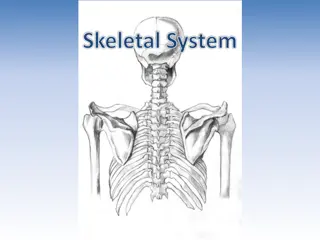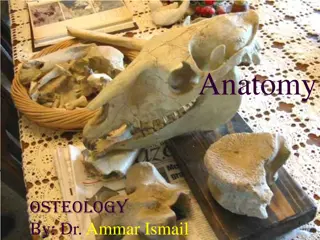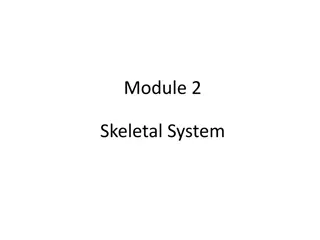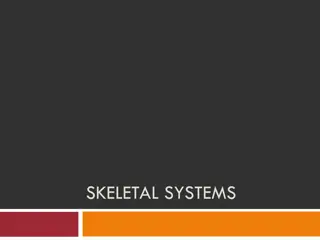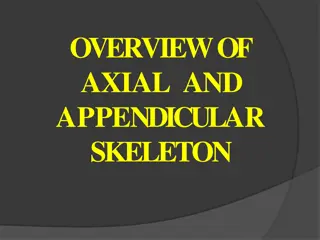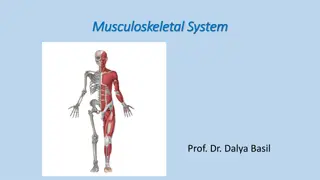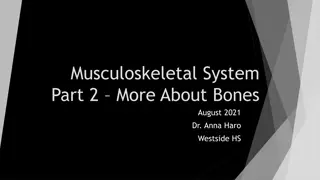Exploring the Human Skeletal System
The skeletal system is crucial for protecting organs, providing structure for movement, storing minerals, and producing blood cells. It consists of the axial and appendicular skeleton, with bones classified into long, short, flat, and irregular shapes. Long bones, such as the femur, play a key role
2 views • 28 slides
Understanding Osteology: An Overview of Bone Structures and Skeleton Composition
Osteology is the study of anatomical structures such as bones, cartilages, and the skeleton that support and protect the body. It includes the classification of bones based on shape and function, details on bones of the thoracic and pelvic limbs, and the divisions of the skeleton into axial, appendi
0 views • 15 slides
Comprehensive Guide to the Skeletal System
Explore the fascinating world of the skeletal system, including types of bone, bone formation processes, fractures healing, axial and appendicular skeleton, joints classification, and detailed insights into various types of joints. Dive into the anatomy of the pelvis, paranasal sinuses, and the shou
0 views • 20 slides
Understanding the Human Skeletal System
Explore the functions of the skeletal system, learn about the various types and main bones, understand the importance of bone health, and discover the divisions of the skeleton - axial and appendicular. Dive into the intricacies of bone structure, functions, and how bones support, protect, and enabl
0 views • 12 slides
Overview of Appendicular Skeleton and Bones by Dr. Mahdi H. Hammadi, PhD, Sc. Clinical Physiology
Dr. Mahdi H. Hammadi, PhD, Sc. in Clinical Physiology, provides an insightful look into the bones of the appendicular skeleton, including the shoulder girdle, upper limbs, wrist bones, and hand bones. The text covers the composition and functions of these skeletal elements in a comprehensive manner,
0 views • 21 slides
Understanding the Anatomy of the Skeletal System
Explore the two major sections of the skeletal system: the Axial Skeleton, which provides protection to vital organs, and the Appendicular Skeleton, enabling movement. Discover variations in bone structure across species, from horses to dogs, and delve into the bones of the Axial Skeleton, including
0 views • 29 slides
Understanding the Regional Anatomy of the Body: A Kinesiology Perspective
Explore the intricacies of the human body's skeletal structure through a regional approach as outlined in kinesiology books. Delve into the axial and appendicular skeleton, facial muscles, skull anatomy, importance of wearing a helmet, facial bones, back region, and the vertebral column. Learn about
0 views • 12 slides
Understanding the Axial and Appendicular Skeleton in Vertebrates
The axial skeleton consists of the bones in the head and trunk, while the appendicular skeleton supports the limbs in vertebrates. The appendicular skeleton aids in locomotion and manipulation, comprising 126 bones in total. Understanding the structure and functions of these skeletal systems is vita
0 views • 23 slides
Understanding the Musculoskeletal System in the Human Body
The musculoskeletal system, comprising the muscular and skeletal systems, supports body movement, stability, and shape. It includes muscles, bones, tendons, ligaments, and joints. This system serves functions like providing support, protection to vital organs, mediating movement, and producing blood
0 views • 36 slides
Exploring Human Skeleton Anatomy: Bones, Structure, and Functions
Delve into the intricate details of the human skeleton, including the organization of bones in the axial and appendicular skeletons. Learn about the different bones comprising the skeletal system, their functions, and the significance of memorizing 144 bones. Discover learning objectives related to
0 views • 8 slides
